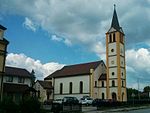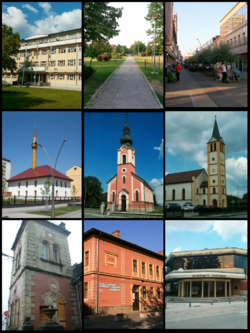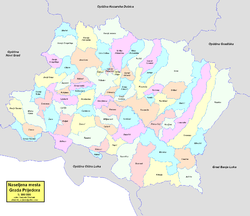|
Prijedor
  Prijedor (Serbian Cyrillic: Приједор, pronounced [prijěːdor] ⓘ) is a city in the entity of Republika Srpska, Bosnia and Herzegovina. As of 2013, it had a population of 89,397 inhabitants within its administrative limits.[2][3] Prijedor is situated in the northwestern part of the Bosanska Krajina geographical region. Prijedor is known for its mixed religious heritage comprising Eastern Orthodox Christianity, Roman Catholicism and Islam. Historic buildings from the Ottoman and Austrian-Hungarian periods are a feature of the urban landscape. The city underwent extensive renovation between 2006 and 2009. GeographyThe urban centre of Prijedor, within the city of Prijedor, is located in the northwestern part of Bosnia and Herzegovina, on the banks of the Sana and Gomjenica rivers, and at the southwestern hills of the Kozara mountain. The area of the municipality is 833 square kilometres (322 square miles). The town is situated at 44°58'39" N and 16°42'29" E, at an altitude of 133 metres (436 feet) above sea level. It is traditionally a part of the historical and cultural region of Bosanska Krajina in Bosnia and Herzegovina. The terrain ascends to the northeast of Prijedor in waves and gradually becomes the mountain range of the Kozara mountain, which is famous for uprisings in the previous centuries and battles against fascism during the Second World War. The city lies on the alluvial terrain created by the Sana river and its tributaries on the southwestern hillsides of the Kozara mountain. Climate
HistoryAncient periodPrijedor's history as a fortified population centre can be traced back to the end of the 17th century,[5] but the history of the colonization and surrounding culture is much older. Numerous prehistoric, ancient and medieval archeological sites are evidence of the presence of a variety of different cultures. There are numerous settlements from the prehistoric period, dating back to 2100 B.C., usually associated with burial sites. In the pre-Roman and Roman times the area was settled by a large Illyrian tribe, the Maezaei,[5] a sub-tribe of the Pannonians, renowned for their mining skills. In nearby Ljubija, many Roman monuments have been found that provide evidence of iron production. In Zecovi there is an Illyrian necropolis from the Iron Age. A legend says that the river Sana was named by the Romans. Ottoman and Austrian PeriodPrijedor is mentioned for the first time as a small wooden fort in the list of those places in the Ottoman Empire that were devastated by Croatian troops between 1693 and 1696.[6] In this part of Bosnia a large number of fortifications were constructed in order to protect often contested borders with Austria. Later on, many fortifications were destroyed during the Austro-Ottoman War as the borders moved towards the east and south in favor of Austria. The first mention of the city, being referred to as “Palanka Praedor”, was in a Latin written report of an Austrian field marshal about fortified settlements that were burnt between 1693 and 1696. The term “Palanka” indicates a wooden fortification built on an artificially created island on the river Sana. It is not clear how Prijedor got its name, but there are two theories. One of them refers to the term “prodor” in the local language, meaning penetration, i.e. penetration of the Sana river, which often flooded the entire area. The second theory concerns a race between a man and a horse (a horse is commonly known as “Doro”). It is said that the man reached the finish line before the horse, saying in the local language: “Prije Dore (Before Doro.).". At the same place in the middle of the 18th century, a new fortress appeared, this time built with stone walls, three towers and two clay causeways for the cannons. Archives from Istanbul dating back to 1745 tells about two town guards crossing over to the newly built Palanka Pridorska Ada (island). It is the first mention of the fortress on the river Sana where the town later developed. With the emergence of the fortification, the settlement outside of the walls began to develop at the same time. The settlers were probably Christians who lived in the vicinity and whose settlements rapidly merged with the town as it expanded to the north. Attesting to this is an account of an Austrian secret agent about the existence of the town for the purposes of the Austrian army, in which he described the town in detail and especially emphasized the suburbs in its vicinity. These regions were under Ottoman dominion until 1878. The town started to develop rapidly thanks to the navigability of the Sana River, the development of trade and crafts, and later the construction of the first railway through Prijedor. The first railroad in Bosnia and Herzegovina was built in 1873 next to Prijedor and went from Dobrljin to Banja Luka. The fortress existed as a military base until 1851 when the army left and the walls were demolished by the local population who used the walls to build their own houses. A huge fire in 1882 destroyed 119 houses, 56 big commercial stores, schools, an Eastern Orthodox church, and 140 families lost roofs over their heads. The next year the Austrian authorities opened a large sawmill at the bottom of the mountain Kozara, which is the first industrial object in the history of Prijedor. The years after the fire there was intensive development of the town, encompassing both private and state-owned structures. The wood was replaced with modern building materials, the streets were designed at the right angles and the first town plan was created. New buildings were built, such as the Serbian elementary school, a Catholic Church, an Eastern Orthodox Church, and a hotel. The first cultural associations appeared in the town as well as libraries, reading rooms and a printing house. The end of the First World War created a fledgling state—the Kingdom of Serbs, Croats, and Slovenes—with Bosnia and Herzegovina as a part of it. Prijedor was an important place as the trade and crafts centre of the whole region. The opening of an iron ore mine in nearby Ljubija in 1916 strengthened the economy of the town.[7][8] During that period, the mine was one of the biggest and most modern iron ore mines in Europe. From 1929 to 1941, Prijedor was part of the Vrbas Banovina of the Kingdom of Yugoslavia. World War IIThe memorial centre Mrakovica at Kozara, the work of the academic artist Dušan Džamonja, is dedicated to this region's Yugoslav Partisans and predominantly Serb civilians killed or deported to Ustaše concentration camps during the German-Ustaše-Hungarian Kozara Offensive from June to July 1942, during World War II. Some villages around Prijedor and Kozara Mountain suffered the deaths of tremendous numbers of civilians, who were killed by the Ustaše and taken to different concentration camps during the genocide campaign; one of these was Jastrebarsko Concentration Camp, where children were imprisoned.[citation needed] Bosnian warDuring the Bosnian War (1992–1995), the area near Prijedor housed the Omarska, Keraterm, and Trnopolje camps established in 1992 for the Bosniak and Croat population.[9][10][11] DemographicsPopulation
Ethnic composition
Education The first forms of organized education can be traced back to the first half of the 19th century. In 1834 Prijedor had the "Serb elementary school" that later with the so-called "Communal school" was transformed into the "State school" in 1919. One of the earliest and most important educational institutions was the Prijedor Gymnasium, founded in 1923.[12] Elementary and High schools Nowadays, there are 11 elementary schools with circa 8,000 students and 6 high schools attended by around 4,000 students. A music school and a special school for mentally challenged people are also part of the city educational system. Colleges and Universities Over the last several years, important steps have been taken, aimed at establishing colleges. As a result, Prijedor now has a University college of Economics and IT,[13] a University College of Medicine,[14] and a mining geology department of the University of Banja Luka. In the northwestern part of the city in the neighborhood of Pećani a Law and Economics faculty is under construction. These are the first steps to establish an independent university centre in Prijedor. Today, Prijedor has around 1300 enrolled students.[15] Economy Prijedor is a large service and industrial centre and hosts some of the largest companies in Bosnia and Herzegovina. It has a developed financial sector; 11 international banks are represented in the city, as well as 5 microfinance organizations and a foundation for development. The city's huge economic potential lies in its strategic geographical location, as it is close to Zagreb, Belgrade, Budapest and Vienna, giving it one of the best climates for economic expansion in Bosnia and Herzegovina. The arable land around the city, raw minerals and growth of the highly educated population in the city proper gives it a unique combination of both being able to produce sophisticated industrial products, and food and service industries.
The following table gives a preview of total number of registered people employed in professional per their core activity (as of 2018):[16]
Companies The city today hosts the Bosnian headquarters of the ArcelorMittal Steel Company, which is the world's largest steel company, with over 320,000 employees in more than 60 countries. Prijedor also contains companies specialized in the chemical industry such as Ferrox A.D., producing iron oxides and pigments. BosnaMontaza A.D., one of Bosnia and Herzegovina's most specialized steel manufacturers, manufactures steel, pipelines, reservoirs, technological equipment, cranes and energy plants. Other companies such as the Croatian food company Kraš has one of its biggest facilities in Bosnia and Herzegovina in Prijedor, producing confectionery products under the brand names MIRA and Kraš. Brand names such as "Prijedorčanka" are one of the leading producers of the alcoholic beverage Rakija in Bosnia and Herzegovina, placing its products in Bosnia and Herzegovina, Serbia and Croatia. Celpak Prijedor used to be a big enterprise producing cellulose and paper for export, but has since been shut down. SectorsAgricultural sector Aside from fishing, Prijedor has a fruit growing industry, gardening industry, agricultural industry, mill and bakery industries, animal husbandry, processing industry, as well as a dairy industry.[17] Lake Saničani, near Prijedor, is one of the biggest commercial fish farming lakes in Southern Europe. Prijedor city takes up 83,406 hectares (58,450 ha being private property and 24,956 ha state property). Plowed fields and gardens take up 34,026 hectares, orchards 2,386 hectares and vineyards 5,000 hectares. All cultivated soil takes up 40,206 hectares. Service sectorThe service sector in Prijedor is growing rapidly and this is reflected in the growth of hotels, stores, roads, educational facilities and shopping centres that are being built in the city, making it a growing commercial hub in Bosnia and Herzegovina. Transport and aviation Prijedor has a high standard of roads thanks to the Prijedor Putevi Company and is planning a highway connection to Banja Luka in the east and Sisak to the west to shorten the distance to Zagreb from the Bosanska Krajina region. A so-called "brzi put", i.e. highway is being constructed to connect Prijedor to the Zagreb-Belgrade highway via Bosanska/Kozarska Dubica in the north. The city is also connected to the rail system in Bosnia and Herzegovina and located on the Zagreb-Sarajevo-Ploče line. The city has a public transport system with 3 bus lines serving 60 stations in and around the city. Prijedor also has an airfield in the northeastern part of the city, in the area of Urije. The airfield has a fleet of light aircraft and sailplanes. The airfield also serves as the home of the city's renowned Parachuting Club. Culture Prijedor has a various number of galleries, religious sights, libraries, statues, fountains, national monuments, cinemas and a city theater. Archeological findings Evidence that Prijedor was settled dates back to 2100 B.C.. Traces of human settlement are evident in the numerous settlements in the region of the present-day city, with necropolises adjacent to the settlements.[citation needed] MuseumsPrijedor is home to the Museum of Kozara founded in 1953, which has a regional status. It is also home to the local national hero, Dr. Mladen Stojanović. His house has been converted into the Stojanović Memorial House. At the Kozara National Park, in the vicinity of Prijedor, there is the Mrakovica War Museum. It includes the Second World War photographs, guns and artillery used during the Battle of Kozara. TheatrePozorište Prijedor was founded in 1953, though the tradition of theatre in Prijedor can be dated back to the 19th century. The theatre hosts different plays during the year, starring actors from within and outside of Bosnia and Herzegovina. Besides theatrical plays, the theatre hosts local city choirs that perform regularly. Religious sites  Prijedor is known for being a multi-religious society, that includes a Catholic church, Eastern Orthodox churches and Mosques. Due to this Prijedor has a large number of mosques in the city centre, one of the oldest dating back to the 16th and 17th century. The most known is the City mosque "Čaršijska džamija" built in 1750 located on the main street. The mosque includes a library and a school. Mostly all of the city's 33 mosques and the catholic cathedral that were damaged have now been rebuilt. Other sights are the Eastern Orthodox church "Crkva Svete Trojice" built in 1891, which is surrounded by a wall including a small church park. The catholic cathedral "Sv. Josip" built in 1898 is located in the northern part of the city centre close to the city theatre. Prijedor used to have a small Jewish population before WWII and the Bosnian war, but nowadays there are no traces of the former Jewish population in the city.[18] CultureFestivalsThe Day of Honey: Locally called "Dani meda". A trade and tourist event where local honey producers from the Prijedor area and beyond gather at the square in the main street to sell and demonstrate their products.[19] The Prijedor "Summer on the Sana" Festival: "Ljeto na sani". Cultural, artistic and other events along the city river shore.[20] Writers' Gathering: Each year in September, a cultural gathering "Writers' gathering in Kozara", where works of literature by local authors are presented, takes place. The Days of Winter: This tourist event is held at the beginning of February in the mountain Kozara. It lasts three days and its main aim is to promote tourist potentials of the Kozara mountain. Sporting and gastronomic competitions followed by a rich entertaining programme are an integral part of this event. International Chorus Festival – Zlatna Vila: This cultural event is held in The National Theatre of Prijedor every May and it represents a competition in choral singing. Participants of the festival are choirs from different countries both from ex-Yugoslavia and beyond. St Peter's Day Parachuting Cup: Each year, in the month of July, a sporting event, the St Peter's Day Parachuting Cup, is held. Parachutists from different countries take part in this event, and competitions are organised in various categories: women, men, juniors and teams. SHA Fest (ŠA Fest): A non profit annual festival of music and arts established to honour the multitalented late artist Dalibor Popović Miksa, which lasts four days. All profit goes to the D.P. Miksa Foundation for the promotion of arts, scholarships and funding of talented artists.[21] SportsThe local football club, FK Rudar Prijedor, plays in the second tier of Bosnia and Hercegovina, The First League of the Republika Srpska. Among the oldest sporting clubs in Prijedor is the football club OFK Prijedor founded in 1919. The tennis club of Prijedor was founded by Mladen Stojanović in 1932, though tennis was first played in the city in 1914.[22] Every summer since 1967 the Club organizes tennis tournaments in memory of Dr. Mladen Stojanovic (previously Memorijal, now called Prijedor Open). The Kozara skiing centre is located in Mrakovica. All ski lifts are functional and there is a ski path for children in Mrakovica as well. The skiing centre is inside the Kozara national park and there are several possibilities for mountain house rentals. A renovated hotel with various sports facilities lies close to the ski path. Other popular sports in Prijedor are basketball and handball. The highest ranked teams are ŽKK Mladost Prijedor, KK Prijedor (Basketball), and RK Prijedor (Handball). Gallery
Notable people
International relationsTwin towns – sister cities
Partnerships
See alsoReferences
Wikimedia Commons has media related to Prijedor. External links
|
||||||||||||||||||||||||||||||||||||||||||||||||||||||||||||||||||||||||||||||||||||||||||||||||||||||||||||||||||||||||||||||||||||||||||||||||||||||||||||||||||||||||||||||||||||||||||||||||||||||||||||||||||||||||||||||||||||||||||||||||||||||||||||||||||||||||||||||||||||||||||||||||||||||||||||||||||||||||||||||||||||||||||||||||||||||||||||||||||||||||||||||||||||||||||||||||||||||||||||||||||||||||||||||||||||||||||||||||||||||||||||||||||||||||||||||||||||||||||||||||||||||||||||||||||||||||||||||||||||||||||||||||||||||||||||||||||||||||||||||||||||||||||||||||||||||||||||||||||||||||||||||||||||||||||||||||||||||||||||||||||||||||||||||||||||||||||||||||||||||||||||||||||||||||||||||||||||||||||||||||||||||||||||||||||||||||||||||||||||||||||||||||||||||||||||||||||||||||||||||||||||||||||||||||||||||||||||||||||||||||||||||||||||||||||||||||||||||||||||||||||||||||||||||||||||||||||||||||












